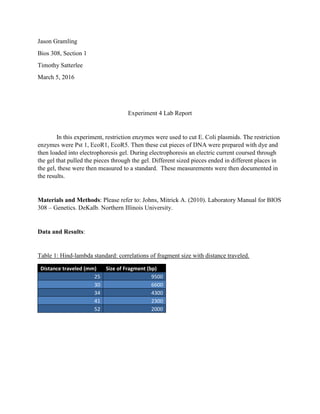
Exp 4 Lab Report
- 1. Jason Gramling Bios 308, Section 1 Timothy Satterlee March 5, 2016 Experiment 4 Lab Report In this experiment, restriction enzymes were used to cut E. Coli plasmids. The restriction enzymes were Pst 1, EcoR1, EcoR5. Then these cut pieces of DNA were prepared with dye and then loaded into electrophoresis gel. During electrophoresis an electric current coursed through the gel that pulled the pieces through the gel. Different sized pieces ended in different places in the gel, these were then measured to a standard. These measurements were then documented in the results. Materials and Methods: Please refer to: Johns, Mitrick A. (2010). Laboratory Manual for BIOS 308 – Genetics. DeKalb. Northern Illinois University. Data and Results: Table 1: Hind-lambda standard: correlations of fragment size with distance traveled. Distance traveled (mm) Size of Fragment (bp) 25 9500 30 6600 34 4300 41 2300 52 2000
- 2. Table 2: pPM1 plasmid from your own group gel or the substitute gel: correlation of fragment sizes with distance traveled. Enzyme Distance traveled y = 37301e-0.06x Total EcoRv 41 3186.81 3186.81 EcoR1 41 3186.81 3186.81 Pst1 41 3186.81 3186.81 EcoR1+Pst1 2341.6 Large band 49 1971.94 Small band 67 669.66 EcoRv+Pst1 2733.41 Large band 45 2506.83 Small band 85 227.41 EcoRv+EcoR1 2624.37 Large band 45 2506.83 Small band 96 117.54 Figure 1: Standard curve y = 37301e-0.06x 1 10 100 1000 10000 0 20 40 60 Size of Fragment (bp) Size of Fragment (bp) Expon. (Size of Fragment (bp))
- 3. Figure 2 – Substitute Gel Figure 3: Computer generated plasmid map from your own gel or the substitute gel. (http://www.infosake.com/plasmid/plasmidFrame.php) 1.Ladder 2.EcoRV 3.EcoR1 4.Pst1 5.EcoR1+Pst1 6.EcoRV+Pst1 7.EcoRV+EcoR1 EcoR1 548bp
- 4. Figure 4: Group Gel 1.Ladder 2.EcoRV 3.EcoR1 4.Pst1 5.EcoR1+Pst1 6.EcoRV+Pst1 7.EcoRV+EcoR1
- 5. Discussion: A plasmid is a special form of DNA found in bacteria. What makes it special is that it is circular in shape. Bacteria use plasmids to share DNA with other bacteria. Scientists have been creating artificial plasmids to manipulate bacteria DNA. (Lodish, Berk A, & al., 2000) In the experiment, a plasmid from E. coli, “pPM1” was used. Restriction endonucleases are specialized protein enzymes that cut DNA. These enzymes are found in prokaryotes naturally as part of restriction- modification systems. These systems have a similar function as our immune system, defending against viruses. (Pingoud & Jeltsch, 1997) In this experiment, three enzymes were used, Pst1, EcoR1, and EcoR5 and three other enzyme were made from combining the three original enzymes. After the enzymes were used to cut the plasmid, they were then dyed. Then the dyed is loaded into electrophoresis gel wells via micropipetting. Electricity is ran through the gel, which pulls the pieces through the gel. Smaller pieces are pulled further through the gel. The resulting pieces are then measured and compared to a standard lambda ladder. The relative size of each of the cut pieces can then be found. This found by comparing the combination enzymes; first by starting with the largest of the small band of the combination enzymes to the smallest of the small band. The result where that EcoR1 was 548 bp away from EcoRV, and Pst1 was 121 bp away from EcoRV. When applying the one of the enzymes into the electrophoresis gel well, I missed the well and the dyed enzyme spilled throughout the gel. This miss made that channel not appear on final results and could have affected other wells as well. This experiment teaches not only on bacteria plasmids and also on electrophoresis procedures. References Works Cited Johns, M. A. (2010). Laboratory Manual for BIOS 308 – Genetics. Dekalb, Northern Illinois University. Lodish, H., Berk A, Z. S., & al., e. (2000). Section 7.1, DNA Cloning with Plasmid Vectors. In Molecular Cell Biology. 4th edition. New York: W. H. Freeman. Pingoud, A., & Jeltsch, A. (1997). Recognition and Cleavage of DNA by Type-II Restriction Endonucleases. European Journal of Biochemistry, pp. 1-22.